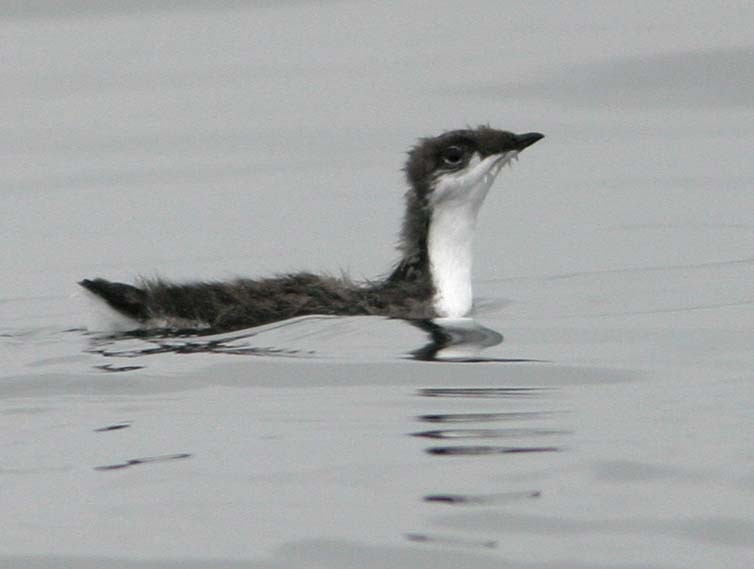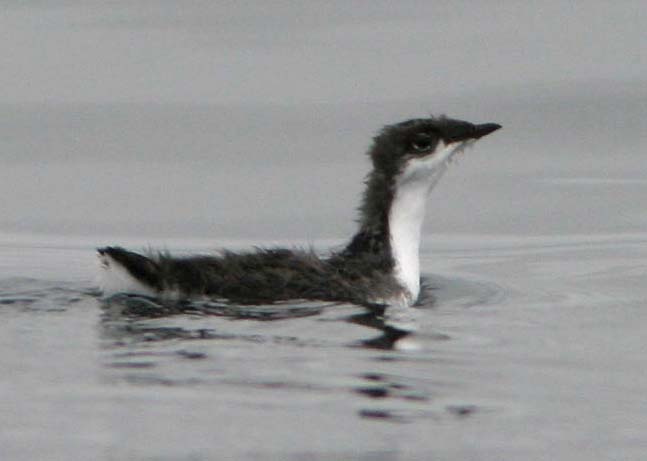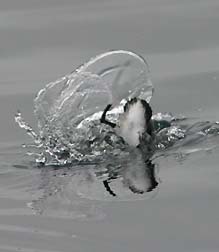
According to the detailed count I made that trip, we saw exactly 20 Scripp's Murrelet. The first 8 were an unexpectedly large bunch, but all others were "pairs" or double "pairs" of murrelets on flat calm seas some 10-12+ nmi SW of Cypress Pt., over deep water off the Monterey Peninsula, California. This was about the 15th bird on the day, accidentally separated from its "mate," but was close to the boat so that I focused on snapping these digital photos. This was one of the highest single-day counts ever, although "up to 40" were seen on a trip on 20 July 1998 (Roberson 2002; Monterey Birds, 2d ed.).
My story starts a year ago on another Monterey Seabirds trip, this one to the offshore albacore grounds. We encountered both Xantus's and Craveri's Murrelets that trip. I got to thinking about the fact that virtually all of these murrelets are found in "pairs," a fact noted as long ago as Dawson's Birds of California in 1923. In Roberson (2002) I reported that the species is "often in pair ... from July to October."
I got to thinking about this. Why were there "pairs" (meaning an adult male and female) in post-breeding dispersal in the early autumn? What happened to the chicks? We know from personal experience at sea in August-October that Common Murres are most often found in twos: but these are an adult and a dependent chicks. We watch the "chicks" grow to adult size and become indistinguishable from the adult by the time of pre-basic molt in mid-fall. We know from researchers that these murre associations are the father and chick association. Why aren't the "pairs" of Xantus's Murrelets we so often find the same thing?
I asked this exact question to a murrelet researcher who gave a talk
at Hopkins Marine Station a year ago, and she didn't know. The most recent
next on the species, Drost & Lewis (1995(, didn't know. That text says
that the precocial young leave the nests at 2 days old and follow their
parent to sea around California's Channel Islands. "Life at sea until independence,"
they say, "is assumed to be similar to that of other Synthliboramphus
murrelets, where single family groups form a close unit and forage together
.... consisting of single chicks accompanied by two adults." If this
were the case, we should be seeing sets of 3 in Monterey Bay in July-August
— and we occasionally do — but the vast majority are sets of two. The text
also notes that "average distance of dispersal and rate of movement has
not been studied." Perhaps current researchers now know more about this,
but I haven't seen anything published yet. So here I go with some proposals
based on the evidence at hand.

The chick shown at the top of the page still has extensive downy feathers above, consistent with the description of a 45 day-old -bird. Let's assume it is, indeed, about 45-55 days old. Its wings are still in sheaths and it cannot yet fly. This explains another curious fact. Of the 20 birds seen on our 14 August boat trip, not a single bird ever flew, despite close approach by our boat. They dove and swan as "pairs" of what now is apparently one adult and a chick (and quite probably the father and chick), keeping in touch by vocalizations (which we heard often). But they did not fly. I propose this was because the chicks could not yet fly.
Later in the season when we encounter "pairs" of Xantus's, they will fly. I suspect these are still father/child associations, but that the downy feathers have been shed and the chicks can no fly. They still vocalize much to stay in touch.
 This
is a slightly different shot of the same bird shown above. The nearest
known breeding colony is on Santa Barbara I., some 450 km (~280 miles)
distant. Assuming this bird is 45 days old or so, and departed the
nest at 2 days old, it was swum the entire distance, meaning it is swimming
at the rate of at least 10 km (6.2 miles) per day. If it swims half the
time during a day, it is swimming at 1 mile per hour. I guess this sounds
within the realm of possibility but still impressive considering the relatively
tiny webbed feet (shown in this dive shot, below).
This
is a slightly different shot of the same bird shown above. The nearest
known breeding colony is on Santa Barbara I., some 450 km (~280 miles)
distant. Assuming this bird is 45 days old or so, and departed the
nest at 2 days old, it was swum the entire distance, meaning it is swimming
at the rate of at least 10 km (6.2 miles) per day. If it swims half the
time during a day, it is swimming at 1 mile per hour. I guess this sounds
within the realm of possibility but still impressive considering the relatively
tiny webbed feet (shown in this dive shot, below).

Scripp's Murrelet typically lay 2 eggs but nesting success on Santa
Barbara I. averages 0.72 checks fledged/clutch laid. Thus most pairs end
up with one chick. The occasionally nest that has two chicks could explain
the groups of 3 we sometimes see on Monterey Bay — presumably one adult
and the two youngsters. The adult catches fish for the young while it is
dependent at sea.
From 1995-1997, Scripp's Murrelets were radio-tagged on Santa Barbara I. Eight of these birds dispersed north to Monterey Bay (Whitworth et al. 2000). Thus we know that some (most? all?) of our local birds come from Santa Barbara I. On 8 Aug 1986, Debi Shearwater & David Suddjian saw what appeared to be two adults with a chick in Monterey Bay (cited in Drost & Lewis 1995, Roberson 2002). I now wonder if this could have been one adult and two chicks (once the down is shed, youngsters look almost identical to adults). I propose that the "usual" alignment is a single adult and a single chick, as documented by these photos, as is typical in Common Murre. This would readily account for the vast majority of "pairs" seen offshore Monterey Bay during post-breeding dispersal, at a time there would be no reason to have adults together but every reason to have an adult accompany each chick.
It is noted that this observation of downy young Xantus's Murrelets was on 14 August — the very first Xantus's to appear this year — and that presumably the down feathers are shed very quickly, thus almost immediately disguising the "truth" of the situation. I find this all fascinating food for thought and enlightening photos, whatever the final "truth" my prove to be.
Finally, all these shots are actually in color! The fact that they look black-and-white says something about the conditions that day . . .
- Drost, C.A., and D.B. Lewis. 1995. "Xantus' Murrelet" in The Birds of North America, No. 164 (A. Poole and F. Gill, eds.). Acad. Nat. Sci., Philadelphia, PA.
- Roberson, D. 2002. Monterey Birds. 2d ed. Monterey Pen. Audubon Soc., Carmel, CA.
- Whitworth, D.L., J.Y. Takekawa, H.R. Carter, S.H. Newman, T.W. Keeney, and P.R. Kelly. 2000 Distribution of Xantus' Murrelet Synthliboramphus hypoleucus at sea in the Southern California Bight, 1995-1997. Ibis 142: 268-279.